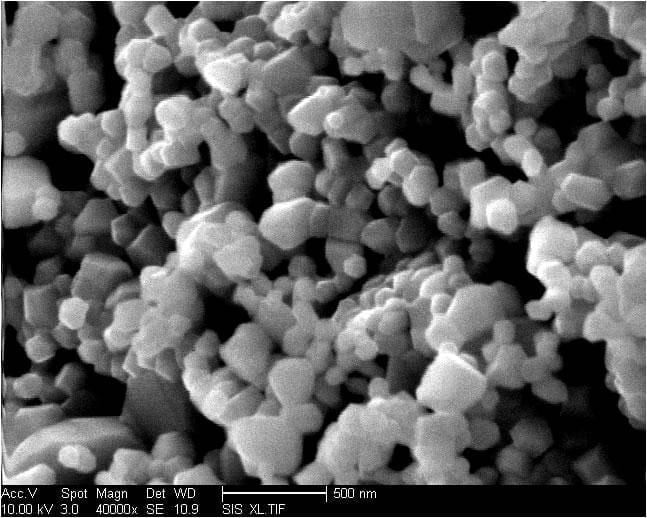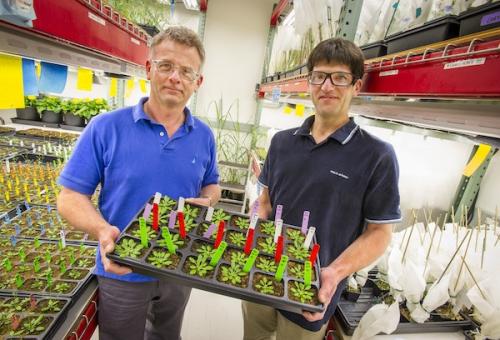
Credit: Renkun Chen, mechanical engineering professor, UC San Diego Jacobs School of Engineering.
SunShot Project aims to make solar cost competitive
A multidisciplinary engineering team at the University of California, San Diego developed a new nanoparticle-based material for concentrating solar power plants designed to absorb and convert to heat more than 90 percent of the sunlight it captures. The new material can also withstand temperatures greater than 700 degrees Celsius and survive many years outdoors in spite of exposure to air and humidity. Their work, funded by the U.S. Department of Energy’s SunShot program, was published recently in two separate articles in the journal Nano Energy.
By contrast, current solar absorber material functions at lower temperatures and needs to be overhauled almost every year for high temperature operations.
“We wanted to create a material that absorbs sunlight that doesn’t let any of it escape. We want the black hole of sunlight,” said Sungho Jin, a professor in the department of Mechanical and Aerospace Engineering at UC San Diego Jacobs School of Engineering. Jin, along with professor Zhaowei Liu of the department of Electrical and Computer Engineering, and Mechanical Engineering professor Renkun Chen, developed the Silicon boride-coated nanoshell material. They are all experts in functional materials engineering.
The novel material features a “multiscale” surface created by using particles of many sizes ranging from 10 nanometers to 10 micrometers. The multiscale structures can trap and absorb light which contributes to the material’s high efficiency when operated at higher temperatures.
Concentrating solar power (CSP) is an emerging alternative clean energy market that produces approximately 3.5 gigawatts worth of power at power plants around the globe—enough to power more than 2 million homes, with additional construction in progress to provide as much as 20 gigawatts of power in coming years. One of the technology’s attractions is that it can be used to retrofit existing power plants that use coal or fossil fuels because it uses the same process to generate electricity from steam.
Traditional power plants burn coal or fossil fuels to create heat that evaporates water into steam. The steam turns a giant turbine that generates electricity from spinning magnets and conductor wire coils. CSP power plants create the steam needed to turn the turbine by using sunlight to heat molten salt. The molten salt can also be stored in thermal storage tanks overnight where it can continue to generate steam and electricity, 24 hours a day if desired, a significant advantage over photovoltaic systems that stop producing energy with the sunset.
One of the most common types of CSP systems uses more than 100,000 reflective mirrors to aim sunlight at a tower that has been spray painted with a light absorbing black paint material. The material is designed to maximize sun light absorption and minimize the loss of light that would naturally emit from the surface in the form of infrared radiation.
The UC San Diego team’s combined expertise was used to develop, optimize and characterize a new material for this type of system over the past three years.
The Latest on: Solar power material
[google_news title=”” keyword=”solar power material” num_posts=”10″ blurb_length=”0″ show_thumb=”left”]
via Google News
The Latest on: Solar power material
- “Terracotta” solar: New 400W PV modules blend in with red clay rooftopson May 8, 2024 at 10:34 pm
Austrian solar manufacturer unveils a new 400W glass-glass TOPCon solar panel that blends aesthetically with tiled terracotta roofs.
- Solar max is coming—the sun just released three X-class flareson May 8, 2024 at 12:17 pm
The sun is increasing its intensity on schedule, continuing its approach to solar maximum. In just over a 24-hour period on May 5 and May 6, 2024, the sun released three X-class solar flares measuring ...
- A low-energy process for high-performance solar cells could simplify the manufacturing processon May 8, 2024 at 7:39 am
Finding reliable, eco-friendly power sources is crucial as our world grapples with increasing energy needs and the urgent call to combat climate change. Solar energy offers one solution, with ...
- Low-energy process for high-performance solar cellson May 7, 2024 at 3:50 pm
Finding reliable, eco-friendly power sources is crucial as our world grapples with increasing energy needs and the urgent call to combat climate change. Solar energy offers one solution, with ...
- This company just launched red solar panels to match terracotta tiled roofson May 7, 2024 at 3:40 pm
Austria's Sonnenkraft has debuted its new "Terracotta" solar panel that matches red-tiled roofs and is historic-building compliant.
- Materials Up Amid Deal Activity - Materials Roundupon May 7, 2024 at 2:32 pm
Producers of metals and other raw materials rallied amid ongoing deal activity. International Paper shares rallied after Reuters reported Brazilian ...
- Can You Use A Brush On Solar Panels? Cleaning Dos And Don'tson May 6, 2024 at 9:15 pm
If you've invested in solar panels, the last thing you want to do is damage them with an incorrect cleaning technique. This is what you need to know.
- Are Solar Panels Recyclable? What You Need To Knowon May 5, 2024 at 6:15 pm
Unless you've had panels installed for decades you probably won't have to figure out a game plan for recycling them, but if you want to, here's how.
- The Evolution Of Solar Energy: How Solar Panels Have Changed Over The Yearson May 5, 2024 at 9:30 am
The evolution of solar is a long story that hasn't come close to finishing. Here's how solar panels have changed and evolved over the years.
- Europe is falling behind in the race to develop space-based solar poweron May 2, 2024 at 7:03 am
Space-based solar power could help solve some of the energy transition woes plaguing Europe. But is it too good to be true?
via Bing News










